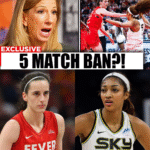
She walked away without saying a word.
They booed, not out of hate—but out of instinct.
And less than 24 hours later, those same fans were the ones being investigated.
It wasn’t the foul that started the storm.
It was the reaction to the reaction.
And it exposed something deeper than a rivalry—
It revealed a league at odds with the very passion it claims to champion.
The moment itself didn’t feel extraordinary.
Caitlin Clark made a take foul. Angel Reese fell hard.
The crowd erupted.
Not in violence. Not in vulgarity.
In volume.
In loyalty.
The kind that fills playoff arenas.
The kind that fuels comebacks.
The kind that makes sports matter.
But the next morning, the WNBA issued a statement:
They were “monitoring fan behavior.”
No mention of Clark’s foul.
No clarification about Reese’s response.
Just concern—about the crowd.
And just like that, the story shifted.
It was a subtle pivot. But a consequential one.
The league didn’t say what, exactly, the fans had done wrong.
No security reports. No ejections. No footage. No incident.
Just… boos.
Normal, raw, real emotion.
And somehow, that became the focus of scrutiny.
In doing so, the WNBA sent a message louder than the crowd it was critiquing:
Controlled emotion is welcome. Unpredictable energy is not.
The fallout was swift.
Online, Indiana Fever fans were stunned.
Clark supporters were defensive.
Even some of the WNBA’s most loyal advocates admitted: this felt wrong.
One longtime beat reporter posted:
“If fans can’t cheer or boo without being reviewed, what’s left?”
Another added:
“We asked for attention. We got it. Now we’re punishing it?”
And perhaps most striking of all—Angel Reese said nothing.
In a week where any word would have gone viral, she went quiet.
Which, in itself, said plenty.
This wasn’t just about one foul.
It was about tension that had been building all season.
Caitlin Clark—the lightning rod.
Angel Reese—the disruptor.
A league trying to grow, and two players whose stories are doing more to elevate it than any marketing campaign ever could.
But instead of embracing the fire, the league tried to soften it.
To police the optics.
To smooth the edges.
And in doing so, it risked alienating the very fans who had finally started showing up.
Because the crowd in Indiana didn’t come to be quiet.
They came to care.
And for the first time in years, the WNBA had something priceless:
Emotion that wasn’t staged.
Drama that wasn’t scripted.
A moment that didn’t need a press release.
And instead of leaning in, the league leaned away.
In any other league, the moment would’ve become a rallying point.
A rivalry renewed.
A star established.
A fanbase electrified.
Instead, it became a cautionary tale.
Because when the WNBA chose to release that statement—vague, cool, oddly misdirected—it didn’t settle tension.
It redirected it.
From the court to the crowd.
From the players to the people.
From the heat of competition to the cold of overcorrection.
And in doing so, the league may have revealed more than it meant to.
To understand why fans reacted so strongly, you have to look at what the WNBA has spent years asking for:
Visibility
Passion
Rivalry
Coverage
Debate
Growth
And now, for the first time in years—maybe ever—it has all of those things.
null
Clark vs. Reese isn’t just about basketball.
It’s about attention.
Momentum.
Cultural pull.
And attention is never neutral.
Caitlin Clark is many things to many people.
To some, she’s a generational shooter with once-in-a-decade vision.
To others, she’s a lightning rod for larger conversations around race, media, and hero-building.
But here’s what can’t be denied:
She brings people in.
She fills arenas.
She drives record-breaking TV ratings.
She makes fans care.
And whether you love her or hate her—you’re watching.
Which, for a league like the WNBA, should be the goal.
Instead, she’s been caught in a system that doesn’t quite know what to do with her.
Because Caitlin Clark isn’t “safe.”
She doesn’t over-explain her actions.
She doesn’t smile for every camera.
She doesn’t apologize for showing fire—or for walking away.
She’s composed. Sharp. Cold when she needs to be.
And that makes her complicated.
The WNBA, on the other hand, has long positioned itself around collective image:
Empowerment
Unity
Strength
Solidarity
Sisterhood
But rivalries challenge that.
They create edges.
And edges aren’t always comfortable.
So when Clark fouled Reese—and walked away—the league had a choice:
Frame it as a moment. Or treat it as a malfunction.
They chose the latter.
The result? Fans—especially in Indiana—felt blindsided.
They had shown up.
They had cheered.
They had booed.
They had cared.
And now they were being policed.
Not for violence.
Not for threats.
Not even for language.
For volume.
The irony?
If the WNBA had said nothing—just let the highlight circulate—this all would’ve passed.
Instead, it created a backlash not just from Clark supporters, but from neutral fans who sensed something deeper was off.
One fan post went viral for its simplicity:
“If cheering your team is a problem, tell me what you want instead.”
Another:
“We finally feel like this matters. Don’t take that away.”
And then there was this:
“I brought my 10-year-old to her first game. She cheered for Caitlin. She booed a foul. Now I have to explain to her why that’s apparently wrong?”
It wasn’t about one incident anymore.
It was about what the league was signaling.
That emotion has limits.
That passion needs permission.
That fandom is only welcome if it behaves.
And that’s not sports.
That’s theater.
In the days that followed, the silence was louder than any press release.
Angel Reese didn’t spike the moment.
Caitlin Clark didn’t complain.
But the internet did what the internet does.
It turned tension into content.
Clips looped. Memes spread. Threads dissected every angle.
And the league’s response became part of the story.
A story not about foul calls—but about perception.
Not about sportsmanship—but about strategy.
Not about one night—but about the WNBA’s identity crisis.
So what happens next?
Maybe nothing.
Maybe another game, another clash, another moment.
But if the league doesn’t learn from this—really learn—it risks turning electricity into silence.
Because the truth is this:
Caitlin Clark didn’t break the league.
She brought it light.
And the only thing worse than dimming that light—
is pretending it was never there.




